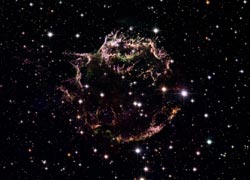Cassiopeia A – The colourful aftermath of a violent stellar death

The colourful aftermath of a violent stellar death A new image taken with the NASA/ESA Hubble Space Telescope provides a detailed look at the tattered remains of a supernova explosion known as Cassiopeia A (Cas A). It is the youngest known remnant from a supernova explosion in the Milky Way. The new Hubble image shows the complex and intricate structure of the star’s shattered fragments.
The image is a composite made from 18 separate images taken using Hubble’s Advanced Camera for Surveys (ACS), and it shows the Cas A remnant as a broken ring of bright filamentary and clumpy stellar ejecta. These huge swirls of debris glow with the heat generated by the passage of a shockwave from the supernova blast. The various colours of the gaseous shards indicate differences in chemical composition. Bright green filaments are rich in oxygen, red and purple are sulphur, and blue are composed mostly of hydrogen and nitrogen.
A supernova such as the one that resulted in Cas A is the explosive demise of a massive star that collapses under the weight of its own gravity. The collapsed star then blows its outer layers into space in an explosion that can briefly outshine its entire parent galaxy. Cas A is relatively young, estimated to be only about 340 years old. Hubble has observed it on several occasions to look for changes in the rapidly expanding filaments.
In the latest observing campaign, two sets of images were taken, separated by nine months. Even in that short time, Hubble’s razor-sharp images can observe the expansion of the remnant. Comparison of the two image sets shows that a faint stream of debris seen along the upper left side of the remnant is moving with high speed – up to 50 million kilometres per hour (fast enough to travel from Earth to the Moon in 30 seconds!).
Cas A is located ten thousand light-years away from Earth in the constellation of Cassiopeia. Supernova explosions are the main source of elements more complex than oxygen, which are forged in the extreme conditions produced in these events. The analysis of such a nearby, relatively young and fresh example is extremely helpful in understanding the evolution of the Universe.
Media Contact
More Information:
http://www.spacetelescope.org/news/html/heic0609.htmlAll latest news from the category: Physics and Astronomy
This area deals with the fundamental laws and building blocks of nature and how they interact, the properties and the behavior of matter, and research into space and time and their structures.
innovations-report provides in-depth reports and articles on subjects such as astrophysics, laser technologies, nuclear, quantum, particle and solid-state physics, nanotechnologies, planetary research and findings (Mars, Venus) and developments related to the Hubble Telescope.
Newest articles

Innovative 3D printed scaffolds offer new hope for bone healing
Researchers at the Institute for Bioengineering of Catalonia have developed novel 3D printed PLA-CaP scaffolds that promote blood vessel formation, ensuring better healing and regeneration of bone tissue. Bone is…

The surprising role of gut infection in Alzheimer’s disease
ASU- and Banner Alzheimer’s Institute-led study implicates link between a common virus and the disease, which travels from the gut to the brain and may be a target for antiviral…

Molecular gardening: New enzymes discovered for protein modification pruning
How deubiquitinases USP53 and USP54 cleave long polyubiquitin chains and how the former is linked to liver disease in children. Deubiquitinases (DUBs) are enzymes used by cells to trim protein…


